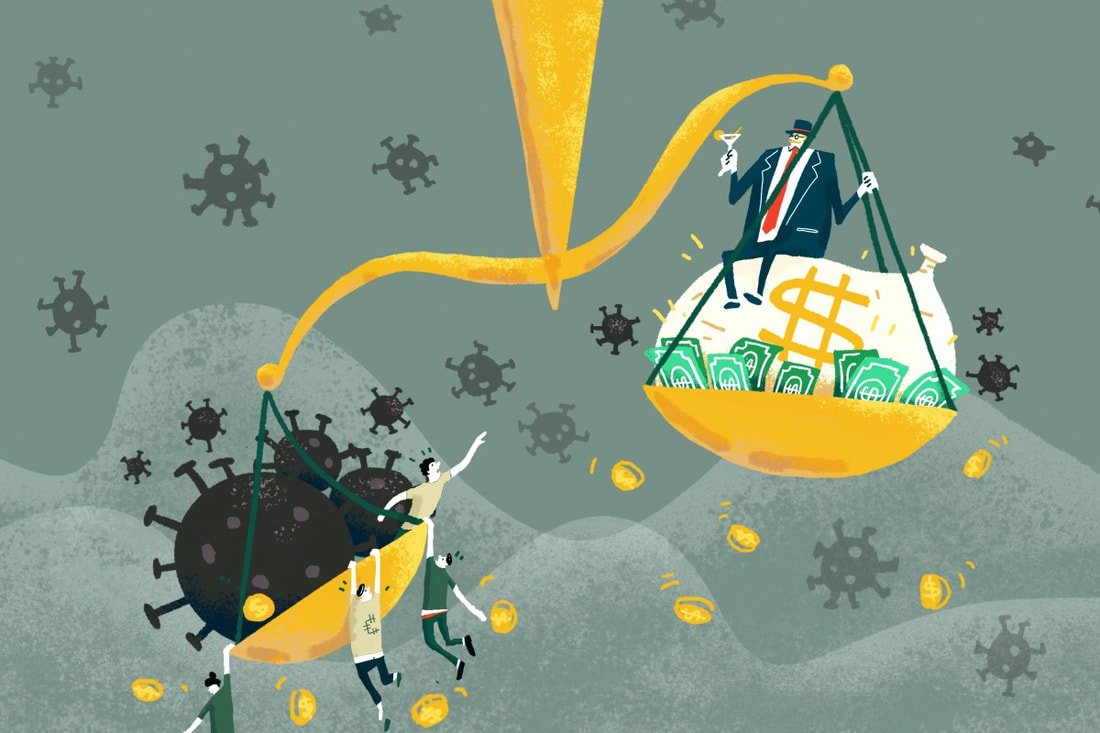|
Threats to our national security are made worse by the increasing income inequality being ignored throughout our country. At a yearly budget of $732 billion, the United States spends more on our military than the next 10 nations combined – to include China and Russia. And yet, this military strength is impotent in the face of the COVID-19 global pandemic. The notion that pandemics represent a national security threat is a foregone conclusion. What is less agreed upon is the fact that income inequality, when combined with such events, represents a national security challenge of its own. In the United States, the top 20 percent of families made more than half of all U.S. income in 2018. The wealth gap between America’s richest and poorest families more than doubled from 1989 to 2016. A recent report indicates that HALF the nation cannot afford a $400 emergency. Much has been written about the United States being the only developed nation in the world to fail to contain the spread of COVID. Part of that failure is due to significant levels of income inequality, especially when compared to that of other developed nations. Income inequality in America is the highest of all the G7 nations (U.S., U.K., Italy, Japan, Canada, Germany, and France). The United States also has the second-largest poverty gap among wealthy nations – Italy is the worst. Is it any wonder, then, that the coronavirus enacted the worst toll on these two nations? The problem is, these extreme levels of income inequality have repercussions beyond the domestic challenges they pose. Even before COVID, we knew that pandemics were especially harsh on the poor. Years ago, studies of the 1918 Spanish Flu determined that the poor are the most affected by the first wave of an outbreak, largely because their economic circumstances prevent them from behaviors known to lessen the impact of an outbreak. Why is this? First, without a home to quarantine into, the homeless are notorious spreaders of the coronavirus. Additionally, those without health insurance (i.e. the poor) are most likely to avoid seeing the doctor, which makes testing, confirmation, and contact tracing all but impossible. This challenge is being made worse, as half of Americans rely on their employer for health insurance, while more than 50 million people have filed for unemployment. Of those that have lost their jobs, the most vulnerable have been the retail and service industries, which employ the most low-wage workers. This lack of health insurance makes matters worse for those who contract the virus, where the cost of treatment is running $35,000. If half the nation can’t afford a $400 emergency expense, suffice it to say that $35,000 is out of their reach as well. There are already reports of potential deaths from coronavirus due to a lack of insurance. As a result of skyrocketing unemployment, millions of Americans are unable to pay rent, and moratoriums on evictions are tenuous at best. More than 30 percent of adults in Florida reported that they missed June’s rent or mortgage payment, and half of those reported that this missed payment was due to the loss of employment. Although Florida’s governor extended a moratorium on evictions, he waited until the 11th hour to make such an announcement (for the second month in a row). Despite a bill in Congress to provide $75 billion in assistance for homeowners, and $100 billion for renters, Republicans in the Senate have vowed to kill the bill. Calls for rent strikes are increasing across the country. Those lucky enough to still have their jobs, deemed “essential workers” in many cases, are predominantly low-wage food industry, custodial staff, grocers, and of course, Amazon. These low-wage workers are most at risk, as they are being told they must go to work on a daily basis, often without adequate personal protective equipment (PPE). Amazon workers have called for a strike against working conditions, and grocers and caregivers are worried about a lack of PPE. So what you have are millions of people who are financially unable to quarantine at home, either because they need the paycheck itself, or the health insurance that comes with employment. Those who have already lost their jobs are more likely to be evicted and homeless, and the lack of insurance will delay their visits for testing and contact tracing. With almost 140,000 deaths, it would be naïve to consider this pandemic as anything but a national security risk. Income inequality in the United States has only exacerbated a healthcare, housing, and insurance crisis brought on by the pandemic. Addressing income inequality may have saved thousands of lives. A more responsive Congress, willing to pay people to stay home (as many European nations have), also may have saved thousands of lives. National security cannot simply mean the threat of terrorist groups, cyber attacks, or rogue states. To counter such challenges, the United States has spent nearly $5 trillion waging recent wars in Iraq, Afghanistan, Syria, and Libya. And yet, the “unseen enemy” of coronavirus has killed more Americans than Vietnam, Korea, and the War on Terror – combined. The biggest threat to the day-to-day security for millions of Americans isn’t terrorism or a foreign power. It’s the fact that half of Americans can’t pay a $400 emergency expense, and 48 million more struggle to cover the cost of food. Another 8.6 million are considered the “working poor,” who live below the poverty line despite full-time employment. These working poor are clustered in certain occupations – retail, food service, custodial staff, and caregivers. The same “essential workers” that are prevented from staying home to combat coronavirus. Most of these workers make less than $10 an hour, and few are unionized, further preventing their ability to negotiate for better working conditions. As COVID spreads, these workers are at the center of the crisis – often without PPE, paid sick days, or paid testing. After ignoring income inequality for so long, COVID is illustrating the need for a discussion about the choice between “guns and butter.” Despite the number of “guns” in the American military, the lack of “butter” has resulted in a larger national security threat than all of the nation’s wars for the last fifty years. Maybe we should do something about that.
0 Comments
In the span of 6 days, the first African-American leader of a US military service was confirmed (General Charles Q. Brown as Air Force Chief of Staff), the Navy’s first black female fighter pilot completed her training (LTJG Madeline Swegle), and the first woman joined the US Army Green Berets (unnamed for security reasons). These are tremendous accomplishments, and should be lauded as such. I have just one question: What took so long? The ban on women in combat was lifted almost 30 years ago, in 1993. The US military was desegregated more than 70 years ago in 1948. Despite these recent accomplishments, only 7% of general officers are African American. The Navy and Marine Corps have no African Americans serving above the 2-star level, and the Army has just one African American 4-star. Burk and Espinoza (2012) argue that some of this disparity is caused by racial discrimination at the unit level, which results in a biased promotion process. Regardless of the cause, the military believes that such under-representation at senior ranks “detracts from military effectiveness.” Similarly, African Americans face a biased military justice system that mirrors that of civil society. African Americans are twice as likely to be incarcerated while in the military, and in a 1992 study, 8% of enlisted black males reported that they had been discriminated against during military justice proceedings. Further, only 38% of black enlisted men believed that white and black people in their unit received the same punishment for the same crime. African Americans also face an increased rate of courts martial, and longer sentences than their white counterparts. Racial diversity is vital to our effectiveness as a military profession, but as evidenced by racial disparities in military justice and discipline, and the lack of diversity in the senior officer ranks — the Armed Forces have much further to go. Richard and Carliss (2012) argue that “diversity is associated with better creative problem solving, innovation, and improved decision making.” Similarly, a Congressional Research Service report argues that “a more diverse force has the potential to be more efficient and flexible, able to meet a broader set of challenges.” “Diversity creates a synergy of different perspectives. This is particularly useful when trying to find solutions to perplexing and wicked problems such as the ones the national-security profession encounters daily.” More generally, a “broadly representative military force is more likely to uphold national values and to be loyal to the government — and country — that raised it.” Simply put, combating racial bias in the military, and in the nation writ large, is a national security issue, as racial and economic divisions at home undermine U.S. security. As Bishop Garrison and Jon Wolfsthal argue so eloquently: “The United States cannot claim to be a beacon of freedom in the world if it continues to witness and accept the ongoing murder of innocent black people. Unless the country makes fundamental changes, cities and communities will continue to be torn apart through over-policing and abuse, economic and racial inequality, and other persistent legacies of racism — all undermining the United States’ ability to function as a society and its credibility on the global stage.” If the response to wearing masks to combat coronavirus is any indication, the United States is currently incapable of building any kind of true national consensus on a variety of issues needed to pursue national security priorities that keep our citizens safe. As a result, we are unable to address global injustice, human rights, peace and stability, democracy promotion, rule of law, and many more issues that we can’t even address adequately here at home. So while the accomplishments of General Brown, LTJG Swegle, and the unnamed Green Beret deserve recognition, it is with a heavy heart that we must also acknowledge that these achievements come far too late for a nation that espouses the equality of all mankind. Will Atkins is an Air Force veteran of 18 years, and writes about the intersection of national security and domestic issues, especially those that affect his home state of Florida. He can be found at @WillAtkins4FL on Twitter. Burk, James and Evelyn Espinoza. “Race Relations Within the US Military,” Annual Review of Sociology, 38 (2012): 401–422. Garrison, Bishop, and Jon B. Wolfsthal (2 June 2020). “An Appeal to the National Security Community to Fight Racial Injustice.” Foreign Policy. Retrieved from https://foreignpolicy.com/2020/06/02/race-relations-police-violence-national-security-community/ |
AuthorAir Force veteran, writing about the intersection of domestic policy and national security, especially as it effects his home state of Florida. Archives
January 2024
Categories |


 RSS Feed
RSS Feed
